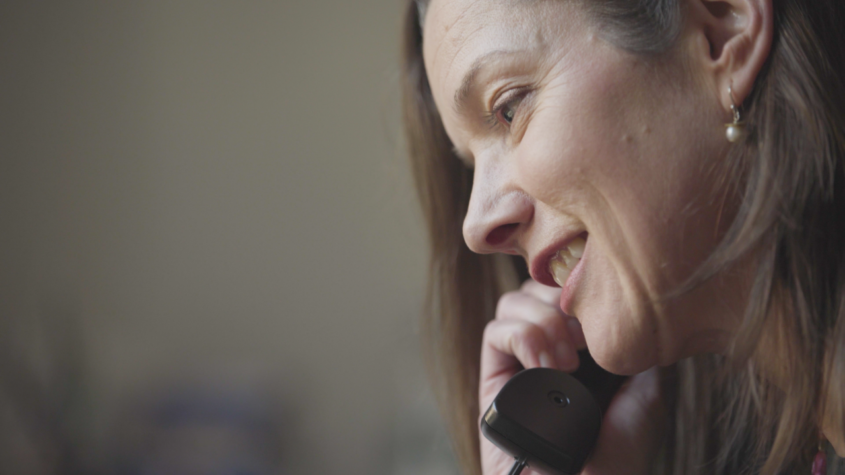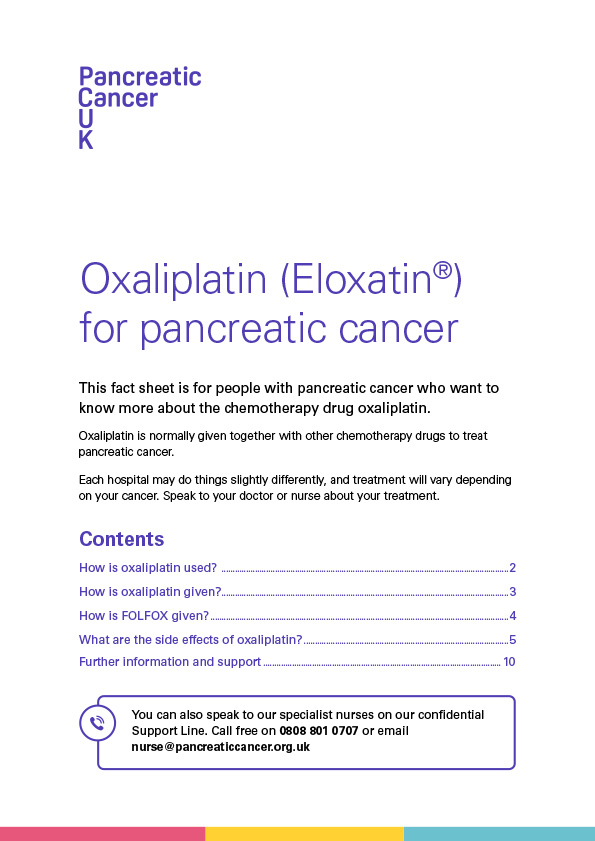On this page you will find informatin about:
Each hospital may do things slightly differently, and treatment will vary depending on your cancer. Speak to your doctor or nurse about your treatment.
The chemotherapy drug oxaliplatin is normally given together with other drugs to treat pancreatic cancer.
Each hospital may do things slightly differently, and treatment will vary depending on your cancer. Speak to your doctor or nurse about your treatment.
Oxaliplatin is normally given together with other drugs to treat pancreatic cancer.
Oxaliplatin is one of the drugs used in FOLFIRINOX:
FOLFIRNOX can be used in different ways.
Read more about FOLFIRINOX and how it is given.
Oxaliplatin is also used in FOLFOX:
FOLFOX may be used if you have locally advanced or advanced pancreatic cancer. It is used for people who have already had gemcitabine with capecitabine (GemCap) or gemcitabine with nab-paclitaxel (Abraxane®).
You will have your chemotherapy at the hospital as an outpatient. This means that you will go into the hospital for treatment, but you will not need to stay overnight.
Oxaliplatin is given as an infusion into a vein. You may hear an infusion called a ‘drip’. You will have the infusion of oxaliplatin through a cannula, or through a central line, such as a PICC line or a portacath. Read more and see diagrams of cannulas and central lines.
Oxaliplatin is given together with other chemotherapy drugs in the treatments FOLFIRINOX and FOLFOX. Read about how FOLFIRINOX is given.
FOLFOX is given in a two week cycle. On the first day of each cycle you will have an infusion of oxaliplatin and folinic acid. You will then have an injection of fluourouracil into a vein.
After this you will have an infusion of fluourouracil over 46 hours. This is given through a small pump attached to your central line. You can have this at home by attaching the pump to a belt and carrying it around with you. You will then have a break from chemotherapy for the next 12 days.
Each chemotherapy team will give the FOLFOX drugs slightly differently. Speak to your chemotherapy team about how you will have FOLFOX.
Some people have a reaction while oxaliplatin is being given. Signs of a reaction are:
A reaction needs treating straight away, so if you have any of these or any other unusual symptoms, tell your chemotherapy team.
Oxaliplatin can cause side effects, but these can affect everyone differently and you may not get all the side effects mentioned here. Your chemotherapy team should tell you about possible side effects and how they are managed. Ask them any questions you have. Knowing what to expect can help you to cope with any side effects. You can also speak to our specialist nurses on our free Support Line.
Your chemotherapy team should give you a 24 hour emergency number to call if you are unwell, have any signs of infection, or if you need information about any side effects. Your nurse will explain when to use this number. If you haven’t been given a number, ask your nurse about this.
Oxaliplatin can increase your risk of getting an infection. An infection is an emergency if you are having chemotherapy and needs to be treated straight away. Signs of an infection include:
Call the 24 hour emergency number your chemotherapy team will have given you if you have signs of an infection. You should phone if you have any of these symptoms or feel suddenly unwell, even if your temperature is normal or low.
Read more about infections and how they are treated.
Oxaliplatin can affect the nerves in your hands and feet, which can cause tingling and numbness (peripheral neuropathy). This normally gets better after your treatment finishes, but for some people it may never go away. This can feel worse in the cold, so wrap up warm if you are going outside. Talk to your chemotherapy team if you have any tingling or numbness in your fingers or toes.
This is a common side effect of oxaliplatin. You will normally be given anti-sickness medicines before your chemotherapy starts. If these medicines don’t help, speak to your chemotherapy team about changing to a different medicine. We have tips on coping with feeling and being sick.
Fatigue is a side effect of oxaliplatin. It isn’t the same as feeling tired. Fatigue can make you feel weak and have problems concentrating. Some people find that the fatigue starts a few hours to a few days after having chemotherapy and starts to get better after a few days. There are things that can help with fatigue. See how the chemotherapy affects you and work out how much activity you can manage. We have tips on coping with it.
Oxaliplatin may also cause dizziness. Feeling tired and dizzy can affect your ability to drive. You might want to get someone else to drive you until you know if you are affected.
Oxaliplatin can affect your throat, which can make it hard to swallow or breathe. If this happens when you are being given oxaliplatin, tell your nurse straight away. They may stop the infusion of oxaliplatin while they give you medicine to help with this.
You may also get this side effect in the first few hours after having oxaliplatin, but this is normally only if you are out in the cold or having a cold drink. It should stop a few days after your treatment. Speak to your chemotherapy team about how to help prevent this.
Oxaliplatin can make your mouth sore, or cause mouth ulcers which can be painful. Tell your chemotherapy team about any problems you have with your mouth. They can make sure you don’t have a mouth infection and give you a mouthwash which should help. You should also tell them if you have white spots in your mouth. This is a sign of oral thrush, which is normally easy to treat.
During your treatment you may not feel like eating, and you may start to lose weight. Try eating small meals often. If your appetite doesn’t get better after a few days, tell your doctor or dietitian. We have tips on dealing with a loss of appetite.
Oxaliplatin may cause a funny taste in your mouth. Some people say this tastes like metal or cardboard. You may find that food loses its flavour, or you stop enjoying some foods or drinks. Taste changes normally get better once you finish your chemotherapy. You might find our tips for coping with taste changes helpful.
Oxaliplatin can lower the number of platelets in your blood. This is called thrombocytopenia. You may bruise more easily than normal and may be more likely to have nosebleeds or bleeding gums. If you have a nosebleed that does not stop after five minutes, call the emergency number.
Oxaliplatin can lower the number of red blood cells in your blood. This is called anaemia, and can make you feel tired, dizzy, or short of breath.
Oxaliplatin may cause your hair to thin, or you may lose some hair, but it should grow back once your treatment stops.
If you have diarrhoea, try to drink as much water as you can.If you are finding it hard to drink enough fluids, contact your chemotherapy team. If you have diarrhoea more than four times a day, tell your chemotherapy team. They can give you medicines to control it. The dose of oxaliplatin may be lowered, or your chemotherapy may be delayed until the diarrhoea is better. You may find our tips for dealing with diarrhoea helpful.
Constipation is when you find it harder to poo. Drink as much water as you can manage and try to eat high fibre foods such as fruit and vegetables. Gentle exercise such as walking can also help. Speak to your doctor about medicines that can help.
Oxaliplatin can cause problems with your joints, such as swelling or pain. Tell your doctor or nurse if you have this side effect. They can give you painkillers to help. Make sure that you check your temperature before taking paracetamol or ibuprofen. If you have a high temperature, call the emergency number straight away.
Oxaliplatin can cause sore, itchy or watery eyes. Your doctor or nurse may need to give you some eye drops. Some people get blurred vision when taking oxaliplatin, but this is less common.
Oxaliplatin can increase your risk of a blood clot in a vein.
If you have any pain or swelling in one of your arms or legs, or you feel very short of breath, call the emergency number. Or phone an ambulance and tell them you are having chemotherapy. A blood clot can be serious if it’s not treated.
Speak to your doctor or nurse if you experience anything unusual, or if you would like more information.
You can also speak to our specialist nurses for information on oxaliplatin or side effects.

You can download our fact sheet, Oxaliplatin for pancreatic cancer.

Updated April 2022
Review date April 2024